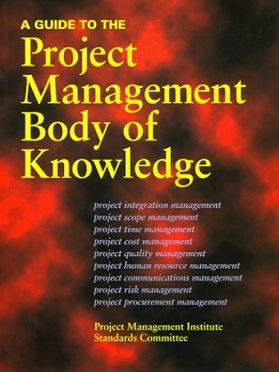Project management is the process of supervising the work of a team to achieve all project goals within the given constraints. This information is usually described in project documentation, created at the beginning of the development process. The primary constraints are scope, time and budget. The secondary challenge is to optimize the allocation of necessary inputs and apply them to meet predefined objectives.
A project plan, according to the Project Management Body of Knowledge (PMBOK), is: "...a formal, approved document used to guide both project execution and project control. The primary uses of the project plan are to document planning assumptions and decisions, facilitate communication among project stakeholders, and document approved scope, cost, and schedule baselines. A project plan may be sumarized or detailed."

The Project Management Body of Knowledge (PMBOK) is a set of standard terminology and guidelines for project management. The body of knowledge evolves over time and is presented in A Guide to the Project Management Body of Knowledge, a book whose seventh edition was released in 2021. This document results from work overseen by the Project Management Institute (PMI), which offers the CAPM and PMP certifications.

A project manager is a professional in the field of project management. Project managers have the responsibility of the planning, procurement and execution of a project, in any undertaking that has a defined scope, defined start and a defined finish; regardless of industry. Project managers are first point of contact for any issues or discrepancies arising from within the heads of various departments in an organization before the problem escalates to higher authorities, as project representative.

PRINCE2 is a structured project management method and practitioner certification programme. PRINCE2 emphasises dividing projects into manageable and controllable stages.
In the PRINCE2 project management method, a product description (PDD) is a structured format that presents information about a project product. It is a management product (document), usually created by the project manager during the process of initiating a project in the initial stage of the PRINCE2 project management method. It is approved by the project board as part of the project plan documentation.

Dynamic systems development method (DSDM) is an agile project delivery framework, initially used as a software development method. First released in 1994, DSDM originally sought to provide some discipline to the rapid application development (RAD) method. In later versions the DSDM Agile Project Framework was revised and became a generic approach to project management and solution delivery rather than being focused specifically on software development and code creation and could be used for non-IT projects. The DSDM Agile Project Framework covers a wide range of activities across the whole project lifecycle and includes strong foundations and governance, which set it apart from some other Agile methods. The DSDM Agile Project Framework is an iterative and incremental approach that embraces principles of Agile development, including continuous user/customer involvement.
Within quality management systems (QMS) and information technology (IT) systems, change control is a process—either formal or informal—used to ensure that changes to a product or system are introduced in a controlled and coordinated manner. It reduces the possibility that unnecessary changes will be introduced to a system without forethought, introducing faults into the system or undoing changes made by other users of software. The goals of a change control procedure usually include minimal disruption to services, reduction in back-out activities, and cost-effective utilization of resources involved in implementing change. According to the Project Management Institute, change control is a "process whereby modifications to documents, deliverables, or baselines associated with the project are identified, documented, approved, or rejected."
The Information Services Procurement Library (ISPL) is a best practice library for the management of Information Technology related acquisition processes. It helps both the customer and supplier organization to achieve the desired quality using the corresponded amount of time and money by providing methods and best practices for risk management, contract management, and planning. ISPL focuses on the relationship between the customer and supplier organization: It helps constructing the request for proposal, it helps constructing the contract and delivery plan according to the project situation and risks, and it helps monitoring the delivery phase. ISPL is a unique Information Technology method because where most other Information Technology methods and frameworks focus on development, ISPL focuses purely on the procurement of information services. The target audience for ISPL consists of procurement managers, acquisition managers, programme managers, contract managers, facilities managers, service level managers, and project managers in the IT area. Because of ISPL's focus on procurement it is very suitable to be used with ITIL and PRINCE2.
Business analysis is a professional discipline focused on identifying business needs and determining solutions to business problems. Solutions may include a software-systems development component, process improvements, or organizational changes, and may involve extensive analysis, strategic planning and policy development. A person dedicated to carrying out these tasks within an organization is called a business analyst or BA.
Product-based planning is a fundamental part of the PRINCE2 approach to project management, and is a method of identifying all of the products that make up or contribute to delivering the objectives of the project, and the associated work required to deliver them. The documents which define the Project itself are also considered Products.
Software project management is the process of planning and leading software projects. It is a sub-discipline of project management in which software projects are planned, implemented, monitored and controlled.
Project governance is the management framework within which project decisions are made. Project governance is a critical element of any project since the accountabilities and responsibilities associated with an organization's business as usual activities are laid down in its organizational governance arrangements; seldom does an equivalent framework exist to govern the development of its capital investments (projects). For instance, the organization chart provides a good indication of who in the organization is responsible for any particular operational activity the organization conducts. But unless an organization has specifically developed a project governance policy, no such chart is likely to exist for project development activity.
Terms of reference (TOR) define the purpose and structures of a project, committee, meeting, negotiation, or any similar collection of people who have agreed to work together to accomplish a shared goal.
Software Quality Management (SQM) is a management process that aims to develop and manage the quality of software in such a way so as to best ensure that the product meets the quality standards expected by the customer while also meeting any necessary regulatory and developer requirements, if any. Software quality managers require software to be tested before it is released to the market, and they do this using a cyclical process-based quality assessment in order to reveal and fix bugs before release. Their job is not only to ensure their software is in good shape for the consumer but also to encourage a culture of quality throughout the enterprise.
In project management, a project charter, project definition, or project statement is a statement of the scope, objectives, and participants in a project. It provides a preliminary delineation of roles and responsibilities, outlines the project's key goals, identifies the main stakeholders, and defines the authority of the project manager. More broadly, this document may be referred to as a "Team Charter" for the purpose of formalizing team roles and task structure at the outset of any team-oriented initiative. Teams that approach a task with a mindful design of team dynamics and task structure are more likely to be successful.
A glossary of terms relating to project management and consulting.
In software engineering, a software development process or software development life cycle (SDLC) is a process of planning and managing software development. It typically involves dividing software development work into smaller, parallel, or sequential steps or sub-processes to improve design and/or product management. The methodology may include the pre-definition of specific deliverables and artifacts that are created and completed by a project team to develop or maintain an application.
Small-scale project management is the specific type of project management of small-scale projects. These projects are characterised by factors such as short duration; low person hours; small team; size of the budget and the balance between the time committed to delivering the project itself and the time committed to managing the project. They are otherwise unique, time delineated and require the delivery of a final output in the same way as large-scale projects.
The following outline is provided as an overview of and topical guide to project management:


